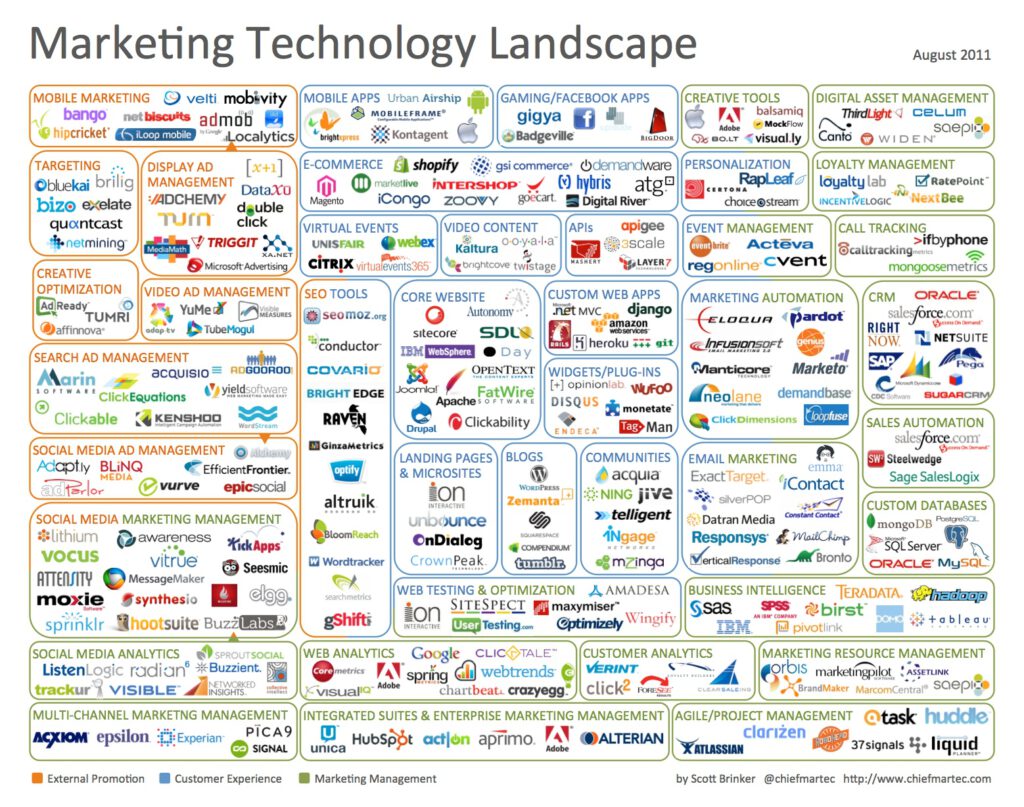Mapping the customer journey is one of the biggest strategic shifts currently underway in the marketing industry. With the rise of social media, the way customers interact with brands has changed forever. Brands can no longer afford to just engage with their customers during a direct interaction, such as when they visit a website or store to make a purchase. Instead, marketers need to understand every touchpoint the customer has with the brand – many of which happen outside of a company’s owned channels.
The current marketing technology (martech) landscape has blossomed out of this paradigm shift, but it’s become unwieldy. A slew of companies and startups are trying to create tools that connect marketers with their customers at different steps in the journey, gather and analyze the data, and figure out how to gain meaningful insights from it. And although it started with the best of intentions, the flood of new solutions actually created more headaches for brand marketers, who are now stuck with a jigsaw puzzle of tools they need to splice together to create a comprehensive picture. Expecting marketers to learn how to use a different tool to collect data at each step of the customer journey is unreasonable, as they are already pressed for time, resources and the know-how required to understand the customer journey and build customer personas – which is the reason they invest in martech solutions in the first place.
You may be familiar with Scott Brinker’s marketing technology landscape infographic that he’s been updating yearly since 2011. It’s one of my favorite references when I talk to anyone about the state of the martech industry. In it, Scott famously plots all of the companies in the marketing technology landscape into a single 16:9 slide.

Yes, you read that right: 3,874 companies. Although this is a 10,000-foot overview of the industry, I am astounded by that number, because it illustrates just how fragmented the market is. There are hundreds of solutions in each of the five main categories that Brinker identifies – Advertising & Promotion, Content & Experience, Social & Relationships, Commerce & Sales, Data, and Management.
From the buyer’s perspective, this landscape is a crowded, overwhelming mess. In terms of the functionalities on offer it is every bit as fragmented and unworkable as it looks in the infographic. Even if marketers are able to narrow down the category and subcategory of a solution they need, there could be dozens of tools to then test and vet. Double or triple that if they need a tool(s) that hits more than one marketing need. It could take months or years to pick the right tool, and then there’s the onboarding process, which can tack on additional months. It’s a daunting prospect for any marketing manager, but especially ones at small- to medium-sized businesses that just don’t have the time to devote to this research and testing process.
Part of the problem is that the industry is still relatively new. In fact, Brinker’s marketing technology landscape only had 150 companies included in 2011.

We’re clearly still in a growth phase, where many solutions are crowding the market and trying to gain their share while it still exists. There are so many untapped opportunities in marketing and customer engagement, but each time a company creates a new tool, it adds to the problem. This can’t continue forever, and eventually we will reach a point where the market will become saturated and begin to consolidate – it’s already happening now. In 2016, Salesforce bought data-management platform Krux, likely to enable powering audience buying and personalization based on non-personally identifiable information data. And Adobe bought TubeMogul to merge the marketing and advertising clouds into one omnichannel tool.
The dominant players are growing by acquisition, bringing in competing or complementary tools to build out their stack and offer a more complete solution. However, many of these are hasty cut and paste jobs that leave you with a clunky, non-intuitive, Frankenstein’s monster of a product. I believe the stage is set for a tool that will completely disrupt and dominate this space. This will be like a 2.0 version of the telephone – a unified platform that handles all communications (from social and chat to email) from a brand to all external stakeholders at every point on their journey with the brand.
Time will tell, but as the industry matures, the most complete tool with the best functionality and ease of use will come out as the winner and successfully complete the puzzle.
By Ulrik Bo Larsen





